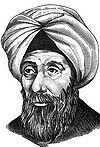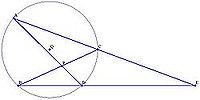Alhazen
Claimed and Written by Ananth Somasundaram for PHYS2211
Alhazen was an Arab physicist, mathematiician, and astronomer who resided in Basra, Cairo. Alhazen had significant contributions in the fields of optics, astronomy, mathematics, scientific method and visual perception. He is considered to be the first theoretical physicist. Alhazen also was the earliest to discover that a hypothesis has the requirement to be experimented through trailed procedures or mathematical evidence. Alhazen is considered by many to be the father of modern optics.

Early Life
Alhazen was born in 965 CE in Basra, Buyid Emirate and passed away at the age of 75 in 1040 CE in Cairo, Egypt. He was born to an Arab family and moved to Cairo at an early age. When he moved to Cairo, it was under the rule of Fatimid Caliph al-Hakim. Alhazen pitched a hydraulic project to improve regulation of the flooding of the Nile. After pitching the idea, Alhazen realized the impracticality of his plan. There is no concrete proof, but it has been told that the Caliph was upset at Alhazen for the failed plan and placed him under house arrest till the Caliphs death in 1040. During the house arrest, Alhazen wrote his famous Book Of Optics.
Contributions
Alhazen had significant contributions in the fields of optics, astronomy, mathematics, scientific method and visual perception as mentioned earlier. He made the correlation that the angle of incidence and refraction does not remain constant. He also researched the magnifying power of the lens. Alhazens work significantly impacted other scientists of his time and future. His book of optics debuted many scientific facts which would be used later in the scientific world. Although Alhazen wrote as many as 200 books, as many as 55 have survived.
Book Of Optics
As mentioned earlier, Alhazen's most significant contribution was the Book of Optics which was created in a span of 10 years with 7 volumes. This book was also translated into Latin at the end of the 12th Centruy. This book influenced Johann Kepler and Leonardo da Vinci.
Theory Of Vision
Alhazen performed experiments on colors and light, reflections, and optic illusions. He would view the refraction of light rays through transparent mediums such as air and water and would record the laws of refraction. He was noted to be the first person to perform experiments on the dispersion of light into colors. He was noted to be extremely close to discovering the theory of magnifying lenses. This theory was officially created three centuries later. Alhazen was the first scientist to consider horizontal and vertical components of refracted and reflected light rays.
Alhazen proposed an intromission theory which said that from all points of a colored body, light and color along every straight line can be produced from that single point. By stating this, Alhazen realized that his theorem had a loop hole: he couldn't explain how a coherent image formed from many independent sources of radiation. Essentially, every point on an object would send rays to every point on the eye. To fix this problem, he stated that only perpendicular rays from the point would be received by the eye. He stated that perpendicular rays are more powerful than oblique rays. He also stated that there was only one perpendicular ray that enters the eye at an point and all the perpendicular rays converge on the center of the eye. Parallel rays are refracted through the eye and perceived as if perpendicular. Johannes Kepler used Alhazen's theory to build off his own theory of retinal imaging which would address the problem of correspondence of points on an object and places in the eye. Alhazen was the first person to experiment and prove that light travels in straight lines and experimented with refraction and reflection.
Alhazen also researched the process of sight and the structure of the eye along with image formations in the eye. He went into the detail of the structure of the human eye and went to consider how the anatomy would behave functionally as an optical system. Alhazen built off of Ptolemy's optic studies.
Alhazen's Problem
Alhazen's problem encompasses drawing lines from two distinct points on the plane of a circle meeting at a point on the circumference and making equal angles with the normal at that point. Alhazen used this in the realm of optics to solve problems when given a light source and a spherical mirror, to be able to find the point on the mirror where the light reflected to the eye of an observer. Alhazen then proceeded to derive a formula for the sum of fourth powers.

Scientific Method
Alhazen believed in reliance on experimentation and controlled testing for his scientific observations. Alhazen especially preferred combining classical physics along with mathematics which helped him believe in his theories of color, vision and light.
Alhazen Wrap Up
Not only was Alhazen heavily involved in optics, he was also heavily involved in the research of celestial objects/astronomy, number theory, geometry, philosophy, and theology. His work is very highly regarded that a crater on the moon is named after him. For number theory, Alhazen contributed his work on perfect numbers. He is a highly regarded physicist whose work can often be overlooked easily.
Connectedness
How is this topic connected to something that you are interested in?
Alhazen sparked interest in me due to my heavy interest in the way light works. I've always been interested in refraction and reflections and also how light travels in a straight line.
See also
Alhazen's work and contributions
References
https://www.youtube.com/watch?v=ljgWdMkZbsg http://www-history.mcs.st-and.ac.uk/Biographies/Al-Haytham.html http://www.photonics.com/Article.aspx?AID=36717 https://en.wikipedia.org/wiki/Alhazen#Book_of_Optics http://micro.magnet.fsu.edu/optics/timeline/people/alhazen.html